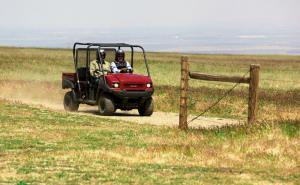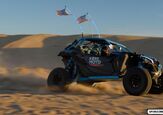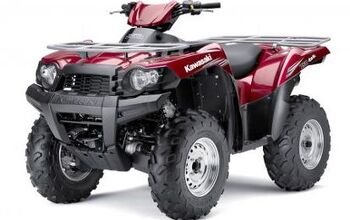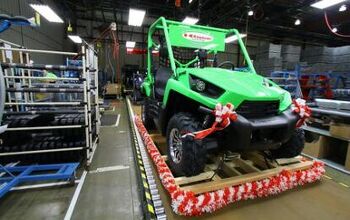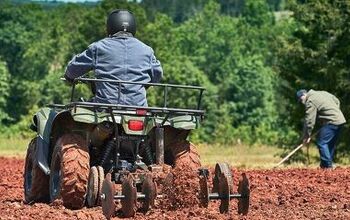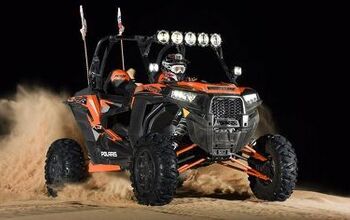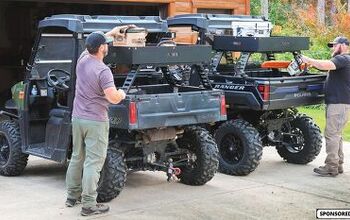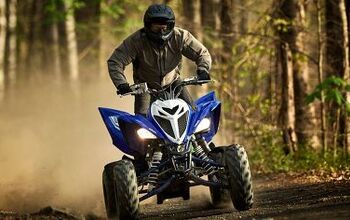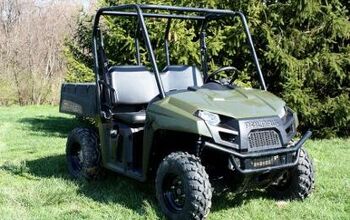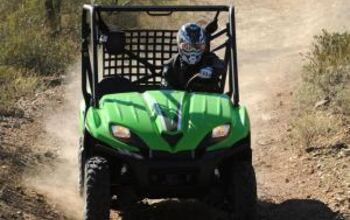2010 Kawasaki Mule 4010 Trans4x4 Review
Kawasaki introduced the first Mule way back in 1988 to provide farmers and construction workers with a heavy duty and more capable alternative to an ATV for doing their serious chores. In 2010 the evolutionary changes continue with the new 4000 series Mules. The 4010 Trans4x4 features all new bodywork designed to look more rugged. There’s also a host of improvements to the cabin area. The dash has been redesigned to include cup holders for the driver and front passenger, dual glove boxes, and a larger front storage compartment. Most importantly however, the TransCab is now equipped with electric power steering and the V-Twin gas engine now has digital fuel injection.
Although the 4010 Mule is also available as a standard cab model with a single bench seat, the TransCab configuration like our test unit gives you the ability to quickly turn the Mule from a standard cab, longbed model capable of carrying 800 pounds in the 50-inch long bed, into a true crewcab, capable of carrying 4 people and still hauling as much as 400 pounds in the shorter 30-inch bed. Either way, the Mule can tow a trailer weighing a total of 1200 pounds. To make the Mule approved for job-site use, the full roll cage meets all of the government ROP (Roll Over Protection) requirements.
Carrying multiple passengers and a big load is what the Mule 4010 Trans4x4 was made for.
Make no mistake; the Mule is designed for use as a workhorse and not a trail ride. You can see that in every detail including the heavy-duty steel floorboards and bed. You can also see the orientation toward work in the layout of the controls. To the left of the steering wheel is a lever for selecting to run the rear differential as open or locked. In locked mode both wheels will turn at the same speed and thereby provide superior traction in mud and snow and uneven terrain. In open mode, it allows the rear wheels to turn at different speeds making it capable of traveling across more fragile surfaces like grass and gravel while afflicting less damage to them. The option of having the rear differential open also tightens the turning radius and decreases tire wear on harder surfaces like concrete and asphalt. To the right of the steering wheel is a lever for selecting between either the 2WD or 4WD modes. Also on the right is the transmission’s Y-gated shifter, with neutral in the center and reverse to the right and rearward. Low range is forward from that and high range is forward and to the left.
Digital Fuel Injection was added to the liquid-cooled, 617cc V-Twin for 2009.
Pointing to its intentions as a work vehicle, the Mule has been governed with a maximum speed of 25mph.
New this year is the Electric Power Steering. Input from the Mule’s speed and torque sensors determines the amount of steering assistance required from the system’s electric motor. At over 1600 pounds, the Mule is no lightweight so the power steering makes maneuvering the Mule around in tight situations much easier – especially on hard-packed surfaces like asphalt and concrete. To keep the power steering unit from possibly running the battery down, the EPS only operates when the engine is running.
Powering the 4010 is a liquid-cooled, 617cc V-Twin industrial engine that now features Digital Fuel Injection (DFI) – a feature first introduced for the 2009 model year. DFI is designed to automatically compensate for changes in the atmospheric pressure, air and engine temperature for easier starting under a wide variety of conditions. For those of us that use our machines in the cold of winter, for hauling hay or plowing snow, the fuel injection proves to be a huge plus for its ease of starting in sub-freezing temperatures. The industrial based engine has been designed for extended use having a large capacity radiator and fan. It is also well isolated having rubber engine and transmission mounts to minimize vibration, noise and wear.
Another feature proving that the Mule was made primarily for work is that the engine is governed for a maximum speed of 25mph. According to Kawasaki this is done at the request of large companies in an effort to provide a safer work-site environment. Maybe that’s true, but for those of us able to use the Mule out in open ranch country or in town, 25 mph is about 10mph too slow!
Like the industrial engine, the CVT transmission has been designed with hours of hard use in mind, with a larger torque converter to maximize the engagement area and a thicker and stronger drive belt for improved heat dissipation and added durability. Even the CVT cover has been designed to help cool the transmission during hard use and is attached in a way to provide for easy belt adjustability. The air intakes for the engine and CVT are located up near the top of the roll cage in an effort to draw cleaner air into the filters for both the engine and the CVT. And like the air filter for the engine, the Mule also has a replaceable filter for the CVT transmission. Located under the driver’s seat is the oil dipstick and filler tube. Oddly enough, also there is the fuel gauge – something we think certainly deserves to be placed on the dashboard for easier observation.
With minimal suspension travel, the Mule can make for a bumpy ride on the trails.
Other than the engine’s governed speed, there is no other feature that keeps the Mule from being used as a trail machine use more than its lack of proper suspension travel. In spite of the Mule’s redesign, the suspension continues as before with struts up front providing 3.9 inches of travel and a DeDion rear suspension with overload springs and 2.8 inches of travel. And, just like the governed speed, the suspension works just fine when used around the farm or construction site. It isn’t until you try to hit a longer section of rough trail that the bumps can quickly and easily exceed the travel.
The brakes are hydraulic-operated, self-adjusting, sealed drums at each wheel. Certainly not leading edge, but more than adequate for utility use. Their simplicity of design and proven reliability are both assets when longevity and inexpensive maintenance are what counts the most. Mounted on steel wheels are 23-inch all terrain tires.
Our Findings
The Mule 4010 Trans4x4 (MSRP $10,699) is very easy to climb into and out of. It’s also incredibly quiet and smooth in its operation. Both are big plusses for working around either people or livestock. We do wish it started in gear with the brake on though. Always having to make sure the Mule is in neutral can get pretty annoying in those situations where you need to constantly be in and out of the machine. We also really think that the governor should have settings for different top speeds so those construction site operators and private ranch owners could choose their desired top speed. And on that same note, the suspension could use about an inch more travel. We also wish the ignition key was closer to the driver, and the fuel gage was on the dash and not under the seat.
But let’s remember that it’s designed to be a workhorse. To that extent, the Mule is solid feeling with proven, bullet-proof construction. Use it for work and you’ll love it. Use it for recreation and you’ll quickly find it lacking.
The Mule 4010 Trans4x4 stands out as a work companion.
Also of note; In our experiences with both gas and diesel models, we’ve found that the incredible torque of the diesel makes it a more powerful and far more unstoppable alternative than the gas model and thus we think, well worth the additional $1,300.
Comparable Vehicles: Kawasaki Mule 4010 Trans4x4 Diesel, Polaris Ranger 800 Crew, Polaris Ranger 6×6, Cub Cadet Volunteer 4×4 EFI, John Deere Gator XUV 4×4 620i, Honda Big Red MUV
Related Reading
More by ATV.com Staff





